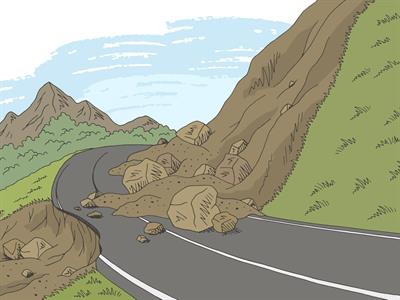
PUMPA - SMART LEARNING
எங்கள் ஆசிரியர்களுடன் 1-ஆன்-1 ஆலோசனை நேரத்தைப் பெறுங்கள். டாப்பர் ஆவதற்கு நாங்கள் பயிற்சி அளிப்போம்
Book Free DemoA landslide is a rapid downward movement of rock, earth, or debris down a sloped section of land under the influence of gravity. Landslides are generally sudden and infrequent.

Steep slope and heavy rainfall, loose earth (soils and rock) are the major causes of landslides. Weak ground structure, deforestation, earthquakes, volcanic eruptions, mining, construction of roads, buildings and railways over the mountains are the other causes of landslides.
Three major causes of landslides are geology, morphology, and human activity.
Human activity, such as agriculture and the construction of roads, railways, buildings, etc., can increase the risk of a landslide. Activities such as irrigation, deforestation, excavation, and water leakage can help destabilise or weaken a slope.
Geology is the characteristics of the material itself. The earth or rock might be cracked or weak, or different layers might have different strengths and stiffness.
Morphology denotes the structure of the land. For example, slopes that lose their vegetation to forest fire or drought are more prone to landslides. Vegetation holds soil in place, and without the root systems, the land is more likely to slide away.
Morphology denotes the structure of the land. For example, slopes that lose their vegetation to forest fire or drought are more prone to landslides. Vegetation holds soil in place, and without the root systems, the land is more likely to slide away.
Human activity, such as agriculture and the construction of roads, railways, buildings, etc., can increase the risk of a landslide. Activities such as irrigation, deforestation, excavation, and water leakage can help destabilise or weaken a slope.
About 15% of India’s landmass is prone to landslide hazards. Landslides are very common along the steep slopes of the Himalayas, the Western Ghats and the river valleys. In Tamil Nadu, Kodaikanal (Dindigul district) and Ooty (The Nilgiris district) are frequently affected by landslides.